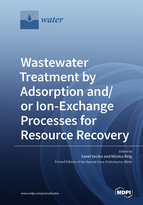Wastewater Treatment by Adsorption and/or Ion-Exchange Processes for Resource Recovery
A special issue of Water (ISSN 2073-4441). This special issue belongs to the section "Wastewater Treatment and Reuse".
Deadline for manuscript submissions: closed (10 September 2021) | Viewed by 21881
Special Issue Editors
Interests: bioactive ingredients; surface-active compounds; natural products; cosmetic formulations; green technology; waste valorization; fermentation; Lactobacillus species; probiotic and prebiotic properties
Special Issues, Collections and Topics in MDPI journals
Interests: membranes; resource recovery; waste to product; acid water; seawater; nanofiltration; electrodialysis; liquid–liquid membrane contactors; ion-exchange resins; agro-food recovery
Special Issues, Collections and Topics in MDPI journals
Special Issue Information
Dear Colleagues,
The triple-R model (reduce, reuse, and recycle) is the essential concept of the circular economy. Due to population growth, the recovery of added-value products from wastes has become a challenge. Wastewaters of different origin (urban, industrial, mining, textile, distillery, and microbial culture, among others) are rich in energy, water, and nutrient sources that can be recovered and reused within a circular economy framework. Recently, wastewater treatment plants have been converted into biofactories, since they can convert waste into new products (water, nutrients, fertilizers, biomethane, electricity, heat, etc.) with a minimal environmental impact. In this context, adsorption and ion-exchange, as well as the integration of both processes, have been proposed as promising technologies for the treatment of wastewaters for resource recovery. Therefore, the aim of this Special Issue, entitled “Wastewater Treatment by Adsorption and/or Ion-Exchange Processes for Resource Recovery”, is to promote these two processes as innovative and environmentally friendly alternatives for the recovery of secondary raw materials from by-products or waste streams. These processes could improve the environmental, economic, and social impacts of the currently used wastewater treatment techniques. We welcome original research articles, reviews, industrial case studies, and short communications.
Dr. Xanel Vecino
Dr. Mònica Reig
Guest Editors
Manuscript Submission Information
Manuscripts should be submitted online at www.mdpi.com by registering and logging in to this website. Once you are registered, click here to go to the submission form. Manuscripts can be submitted until the deadline. All submissions that pass pre-check are peer-reviewed. Accepted papers will be published continuously in the journal (as soon as accepted) and will be listed together on the special issue website. Research articles, review articles as well as short communications are invited. For planned papers, a title and short abstract (about 100 words) can be sent to the Editorial Office for announcement on this website.
Submitted manuscripts should not have been published previously, nor be under consideration for publication elsewhere (except conference proceedings papers). All manuscripts are thoroughly refereed through a single-blind peer-review process. A guide for authors and other relevant information for submission of manuscripts is available on the Instructions for Authors page. Water is an international peer-reviewed open access semimonthly journal published by MDPI.
Please visit the Instructions for Authors page before submitting a manuscript. The Article Processing Charge (APC) for publication in this open access journal is 2600 CHF (Swiss Francs). Submitted papers should be well formatted and use good English. Authors may use MDPI's English editing service prior to publication or during author revisions.
Keywords
- adsorption technology
- ion-exchange process
- process integration
- wastewater treatment
- added-value products
- resource recovery
- circular economy
- industrial application
- waste to product







